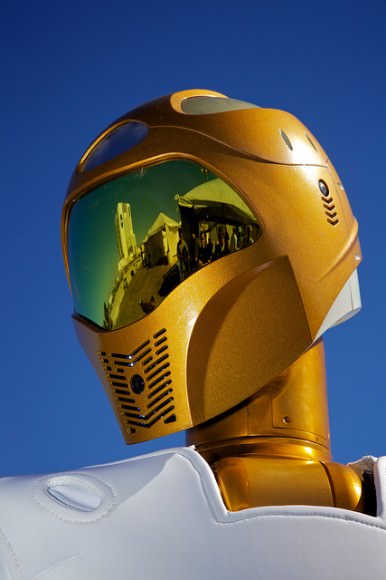
Head shot of NASA's Robonaut. Kennedy Space Center can be seen reflected in the visor. Credit: NASA/JPL/Joe Bibby
When you hear about robots and space exploration, the first thing many people may think of is R2-D2 and C-3PO from Star Wars. While we may not be quite there yet, robots have become a major, even necessary, part of space missions. The many probes, landers and rovers that have been sent throughout the solar system are essentially robots, which have become more advanced over time. Then there’s the new Robonaut, a humanoid robot designed to assist astronauts with a variety of tasks in space including on the International Space Station, for example. But what is next? That was the subject of a panel discussion last Tuesday at the Von Braun Memorial Symposium in Huntsville, Alabama. The future being planned by the robotics experts involved is one of both humans and robots working together in space. The future is now…
“Can we have both robotics and human exploration of space?” was the question of the day. While there have long been advocates of both, there has also been a prevailing debate over which is better; robotic missions are less expensive and don’t put people in danger, but there are some things that only humans could do efficiently and quickly. The rovers on Mars for example, have done an amazing job of exploring the Martian surface, although human astronauts could do a lot of the same tasks faster. Also of course, people can experience the wonder and excitement of exploration in a way that machines can’t.
Instead of choosing between the two scenarios, the best idea, which I personally agree with, is to do both in tandem. That was the focus and apparent consensus of the symposium, that the best way forward is for humans and robots to work together, complimenting each others’ strengths and weaknesses. Humans might be better suited for on-site detailed exploration such as sample-taking, while robots could better handle other, more dangerous jobs.
The use of robotics has become a “pervasive technology across both military and space” according to Dr. Suzy Young of UA-Tuscaloosa’s Research Office. She also cited sources which claim that robotic intelligence could start to approach that of humans by 2040. It may still sound like science fiction, but it is quickly becoming science fact. Maybe those lovable droids from Star Wars aren’t too far off now after all.
Source: Universe Today
No hay comentarios:
Publicar un comentario